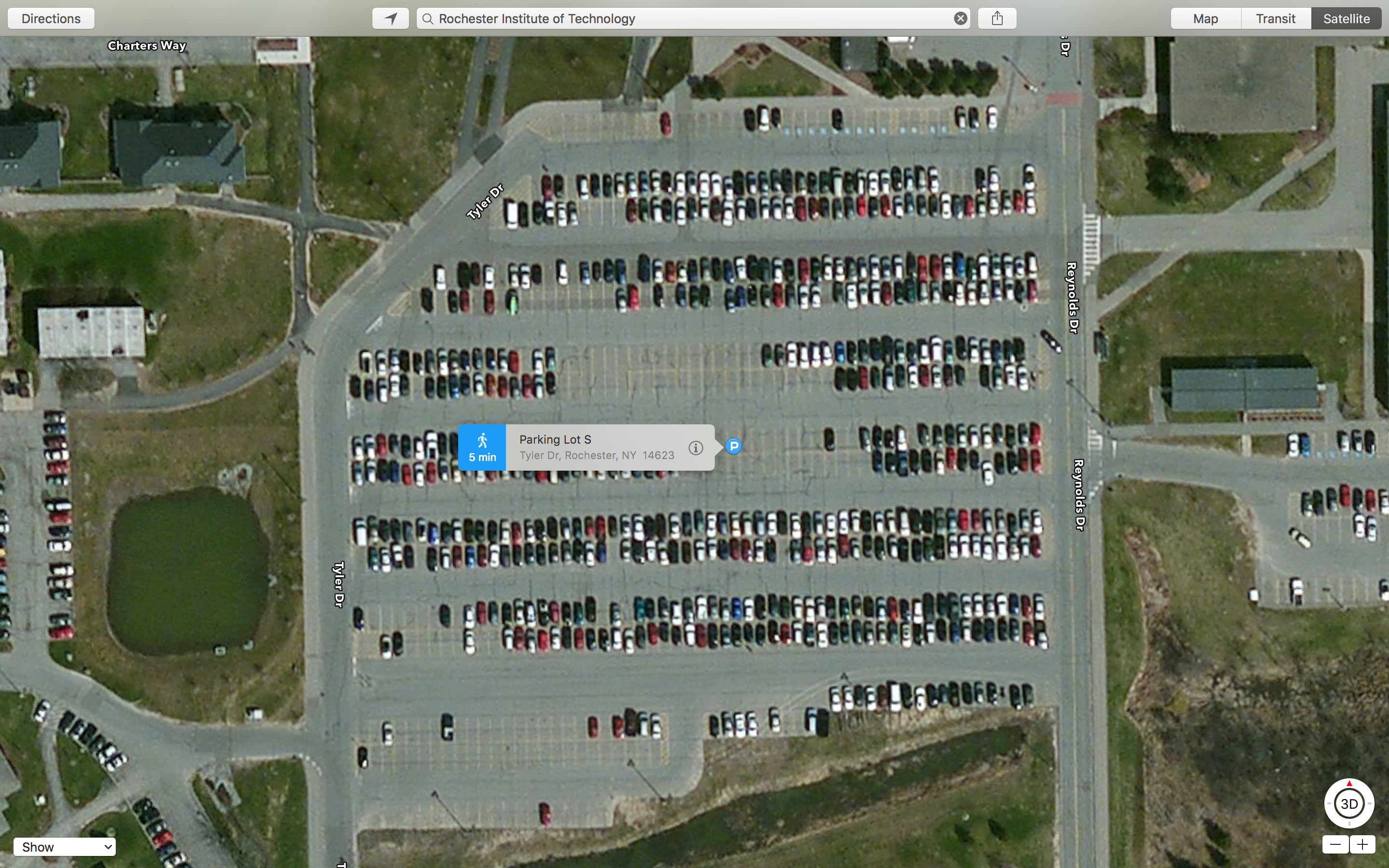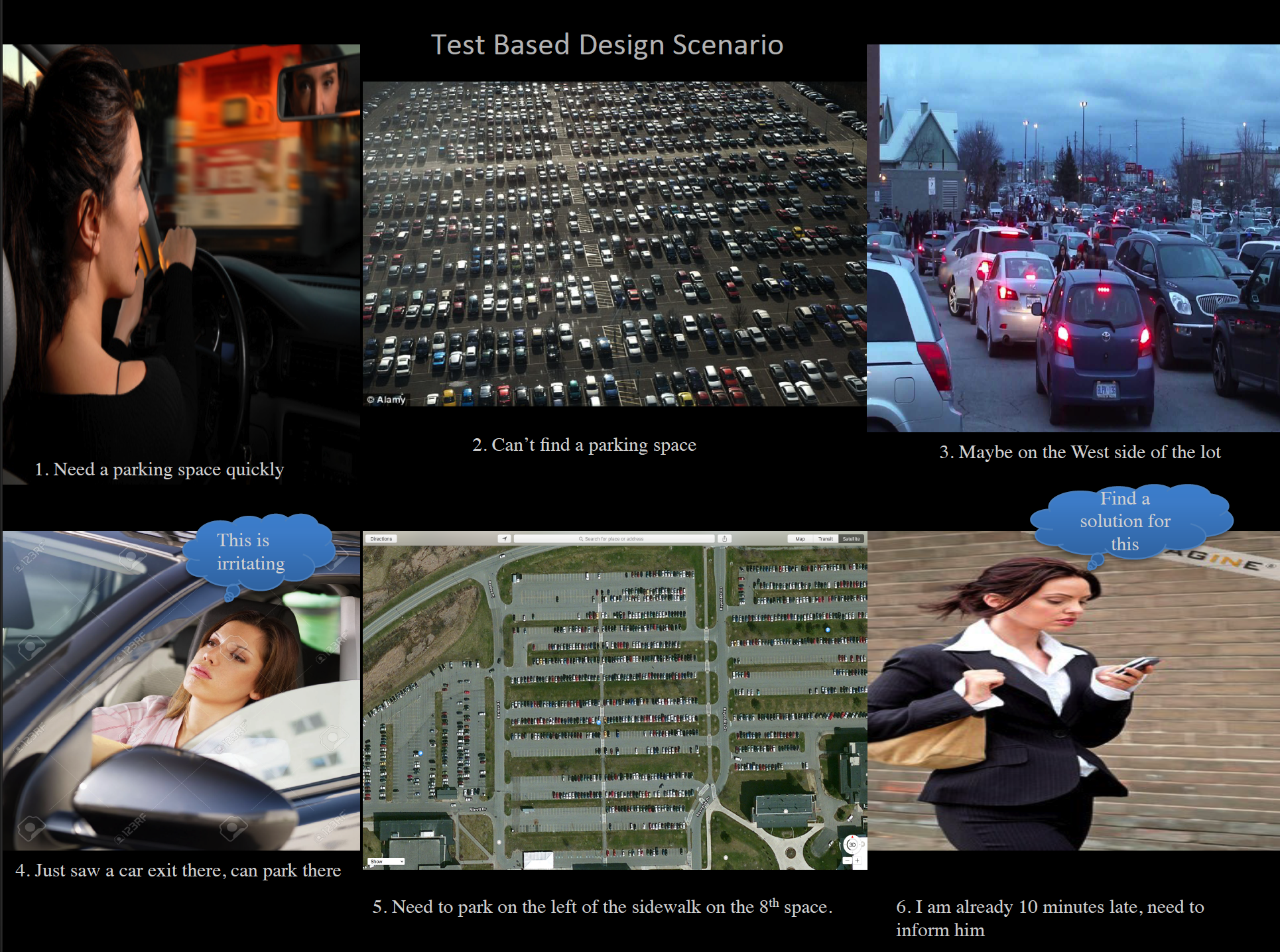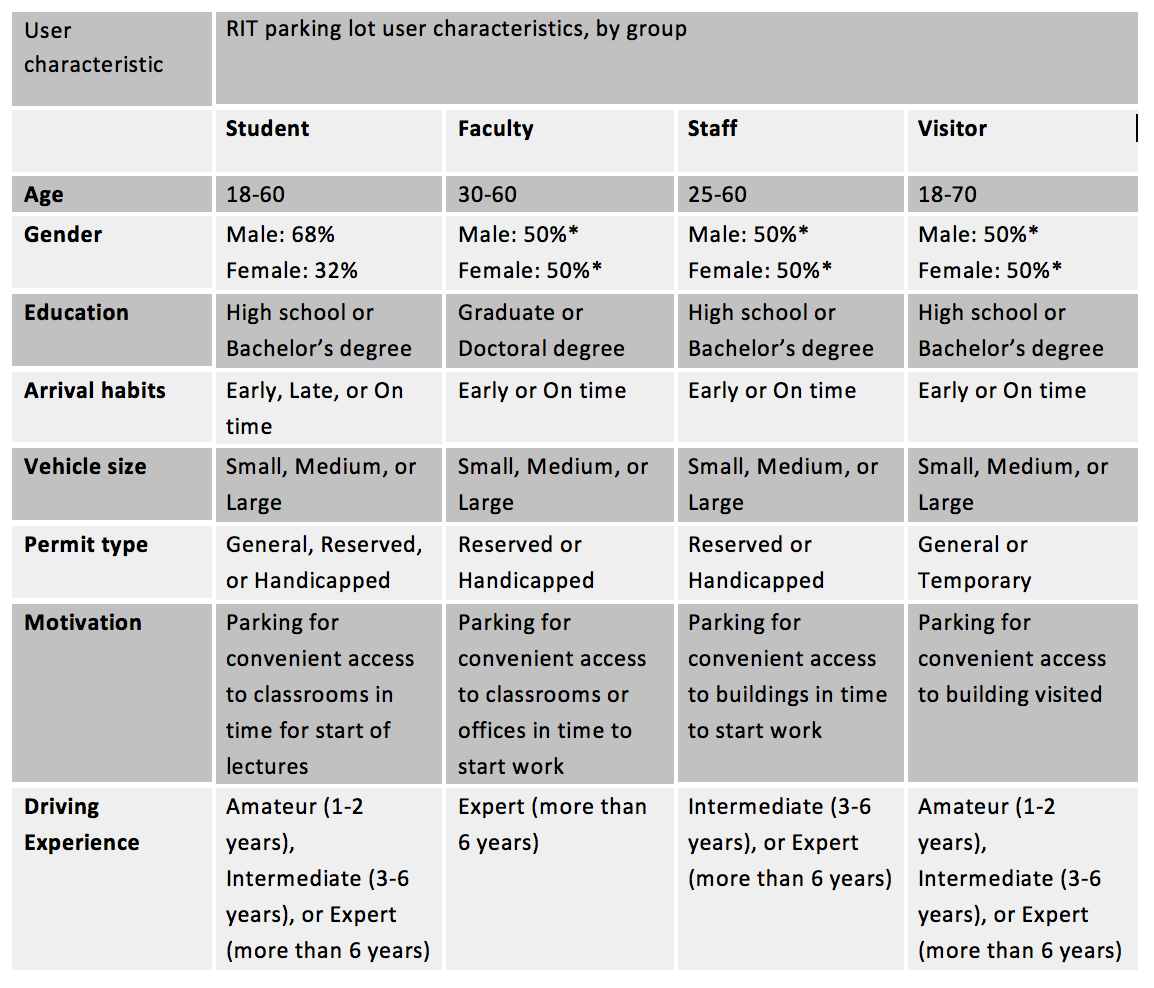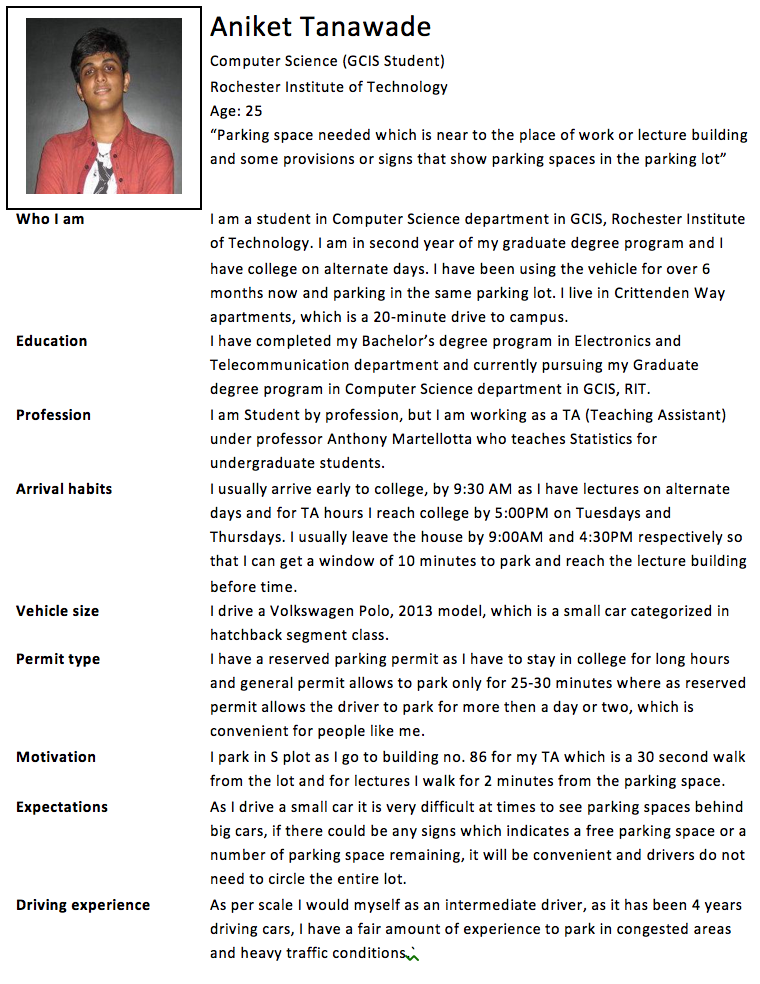Parking Lot Design
Easy parking facility for troubled drivers
This is a process to design an application to assist troubled drivers. As observed, many drivers encounter parking problems when they are in a hurry. So, I've outlined an initial plan to conduct user research on drivers in my college. The first step involves conducting a qualitative analysis of the drivers in the parking lot by observing their behavior. The second step is to conduct interviews with drivers while they drive and ask them appropriate questions. Once we gather the problem scenarios, we can proceed to design the personas (profiles) of the participants. The fourth step is to create a storyboard and scenarios.
- Tools Used: Illustrator

To collect the field data and built a quantitative and qualitative analysis accordingly.
Field Data: - Data of cars parked and cars left from the parking lot was collected. Parking lot S (South of Golisano GOL, Global Village). Time: 12:32PM – 1:35PM, Friday, October 30th 2015. Conditions: C, real feel C, Cloudy, wind speeds up to 30km/h. Spaces: 622 total spaces in the parking lot, all reserved and 70% of the spaces were filled up.
Observation: - In total, 96 cars were observed, with 56 drivers parking their cars and 40 leaving the parking lot. On average, drivers took approximately 50 seconds to 1.5 minutes to park their cars, depending on their approach to the parking space. Drivers arrived at intervals of 3 to 4 minutes, possibly due to the start of a lecture causing an initial rush. The drivers were mostly students, with a few college staff and professors. It was a cold day, so everyone was wearing sweaters. The gender ratio was 65 males to 31 females. Female drivers took 40% more time to park than males. Students attending lectures parked their cars near row 1, while staff preferred spaces after the 3rd row. Most cars entered or exited the parking lot from gate number 2, which is on the right-hand side of the image on the first page. The drivers' ages ranged between 20 and 50 approximately. Some observations led to research and interview questions. For instance, some drivers struggled to find parking spaces due to SUVs obstructing their view. The initial rush to the parking lot prompted questions about parking lot selection and space choice. Additionally, there were too many cars in the S parking lot, leading to questions about convenience and potential solutions. Another odd observation was the varying parking styles, with some cars parked close to the end line and others farther away. This prompted questions about organizational preferences and ease of departure. One possible explanation could be that some people prefer not to reverse while leaving the lot, making it easier for them to exit without wasting time.
To conduct interview with the drivers going to the parking lot (walk through process).
Research Question and Interview Questions: - From the initial observations, several potential research questions arise. A fundamental inquiry would be: “How convenient is parking at RIT?” This could yield various qualitative responses, likely differing based on the specific parking lot and time of day. It's worth noting that different team members conducted independent observations, and different lots were surveyed at different times. While the data indicates that accessing parking in Lot J between 8:15 and 9:15 on a Thursday was relatively easy, findings for Lot E present a contrasting picture, showing limited available spaces during the 4:00 to 5:00 interval. Hence, a more precise research question might prove more beneficial, such as: “What enhancements could enhance the RIT parking system's convenience?” or better yet: “Do drivers' utilization of RIT parking lots suggest potential improvements to the parking system?” This latter question lends itself to data collection and further exploration, as it targets an observable phenomenon – the behavior of drivers utilizing RIT parking lots. The aim of this research is to ascertain whether the observed behavior can identify issues with the current system and, if so, whether any improvements become apparent.
To build profiles and personas of the drivers by taking their problems into consideration.
The following user profile table categorizes RIT parking lot users by the three most common user types: Student, Faculty, Staff and Visitor.
To create a suitable scenario and a storyboard to explain it better.
Test Based Problem Scenario: Persona: Violet, Visitor Setting: RIT Parking Lot J I’m visiting RIT today to meet my husband after his class in Golisano Hall at 11:00. I’m driving my 2011 Toyota Corolla, and the weather is clear and cool. I enter the RIT campus at the main entrance from Jefferson Road; turn right before the roundabout, then left on Reynolds Drive.

To conduct interview with the drivers going to the parking lot (walk through process).
I would like to park as close as possible to Golisano Hall, in Lot J. There are four entrances to the main part of the lot from this road, but I know that the two closest sections of the lot are for “Reserved” permits only, and I have my husband’s General permit, so I have to choose one of the two northernmost entrances. The lot looks to be at least half full, and of course the closest sections fill up first. I can’t see clearly if there are any available spaces, but I have about ten minutes to spare before meeting my husband, so I’ll take a chance and choose the closer entrance. As I turn right into the lot and head west, I see two cars heading toward me from the other side of the lot – maybe one of them has just left an open spot. I continue down the row, but don’t find any open spaces in the eastern half of the lot. I pause at the central crosswalk to yield to a couple of pedestrians. I continue through the lot and reach the western side without finding any open spaces. Those other drivers must have been looking for parking too. I turn right and then right again to head back east down the next row. I see some open spaces, but I want to go as close as I can to the central crosswalk so I pass a few spaces – it’s hard to see if there are any closer ones, so I pick one about eight spaces from the crosswalk, on the left side. I use my turn signal and slow down, and then carefully turn left into the space, and then put the car in park. I turn off the car, get out, then close and lock the door behind me. From here it will take me about ten minutes to walk to the building, and since it took me an extra minute or so to find an available space, I might be a few minutes late to meet my husband. I’ll text him to let him know. Design Scenario: Persona: Aniket Tanawade, R.I.T Student Setting: RIT Parking Lot S I’m driving to RIT today for my 9:30 class in Brown Hall. It’s cool and rainy today, so I hope I don’t have to walk too far in the rain. I’m driving my 2013 Volkswagen Polo, and I have my “Reserved” permit to allow me to park in the closest spaces to the buildings. The lot is very popular and the closest spaces are often full, so as I enter from Tyler Drive on the west side, I look up to consult the LotMonitor at the entrance. The LotMonitor consists of a 8 x 8 foot square display monitor mounted on a pole at the west side of Lot S, and at the top it displays in large bright green text: “Available Spaces: 200 of 622”. Beneath that, there is a graphical representation of Lot S, with all the occupied spaces indicated with a red ‘O’ and all vacant spaces indicated with a green ‘V’. Handicapped spaces are outlined with a blue rectangle and reserved spaces are outlined with a yellow diamond shape. The colors are a quick indication for those with typical vision, while the letters provide the necessary information for colorblind drivers. The building is on the east side of the lot, and I can see that all of the closest spaces in the second and third rows are filled, but the fourth row has several open spaces fairly close to the east side of the lot, so I turn right at the fourth row and drive toward the building. I see one car heading east in front of me in the same row, and the driver parks in a free spot on the left. I saw on the display that there were still two more available spots on the right side of the row further east, so I continue driving, and I find the open spaces, as expected. I use my turn signal and pull into a space. I know that the LotMonitor’s sensors in the parking lot will detect my car and change this space from a white rectangle to a Red signal to indicate to later arrivals that this space is no longer available. The number of available spaces will also be decremented as necessary. I get out, lock the car, and head to my 9:30 class; it looks like I’ll be five minutes early.



